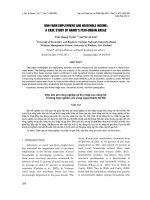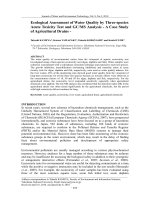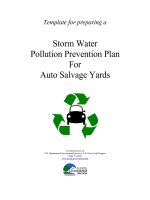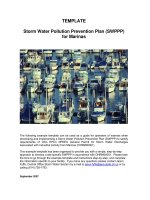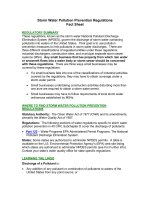Dynamics of Sewage Spillage and Storm Water Pollution on Lake Victoria Basin- A Case Study of Kisumu Municipality pdf
Bạn đang xem bản rút gọn của tài liệu. Xem và tải ngay bản đầy đủ của tài liệu tại đây (104.91 KB, 6 trang )
1
Dynamics of Sewage Spillage and Storm Water Pollution on Lake Victoria
Basin- A Case Study of Kisumu Municipality
Dr. Obiero, ONG’ANG’A
(1)
and Makonge, RIGHA
(2)
(1)
OSIENALA (Friends of Lake Victoria), Executive Director, P.O. Box 4580-40103, Kisumu, Phone: +254-20-
3588681 Fax: +254-20-8028108 email: /osienala.osienala.org P.R China, zip code
(2)
OSIENALA (Friends of Lake Victoria), Programme Officer, P.O. Box 4580-40103, Kisumu, Phone: +254-20-
3588681; Fax: +254-20-8028108 email: / P.R China, zip code
Abstract
Lake Victoria and its basin offer the riparian
communities a wide range of vital environmental and
social-economic services such as fisheries, transport,
tourism, wetlands and water for domestic and industrial
use. However, over the past 30 years these services
have deteriorated as, the lake and water resources in
the basin have experienced intense pressure from
various sources among them sewage spillage and storm
water pollution. This has been due to the rapid
urbanization within the Lake Victoria basin, especially
the growth of urban centers along the shores of the
Lake.
Inadequate attention is paid to sewage spillage and
storm water pollution within urban centers in the Lake
Victoria basin, yet these immensely contribute to the
contamination of the lakes ecosystem and slow
sustainable development of the region.
Kisumu municipality is a major urban center in the
Lake Victoria basin and faces challenges of sewage
and storm water pollution. Short water supply and poor
sanitation framework have overburdened the municipal
creating a situation where semi-treated or untreated
sewage is in some areas discharge directly into water
courses, especially in areas surrounding informal
settlement. The municipals sewage system was
designed to serve about 17% of the current population
and is thus overwhelmed. This results in sewage and
storm water runoff ending up being channelled into the
various rivers and streams that flow into Lake Victoria.
Over 80% of Kisumu residents are not served by the
sewerage system and rely on pit latrines with a small
portion using septic tanks. When full sludges from
these septic tanks and pit latrines are usually disposed
of at the municipals overstretched and malfunctioning
sewage treatment plant ending up into rivers, ground
water and the lake either semi or untreated.
Many residents in the municipality depend on
underground well water for their domestic use. These
wells are poorly constructed and protected and are thus
susceptible to contamination by storm water. In the
rainy season, storm water causes floods and flushes the
faecal matter from latrines. This faecal matter is
deposited into the open wells and contaminating the
water. In the last few years there has been an explosion
of waterborne diseases in the municipality which has
partly being attributed to well water contamination.
Keywords: sewage, storm-water, urban, water
I. Introduction
Lake Victoria is the second largest freshwater Lake
in the world after Lake Superior in the United States of
America. The lake is shared by three countries, Kenya,
Uganda and Tanzania and covers a surface area of
about 68,800 km
2
. The catchment of the lake covers an
area of about 185,00km
2
and traverses five countries -
Tanzania, Uganda, Kenya, Rwanda and Burundi. The
Lake Victoria region has one of the highest
population growth rates in the world. The Lake is
a very important reservoir of fresh water in the region
and supports about 35 million people who depend on
water and natural resources for their livelihood.
As early as the 13
th
and 14
th
century Lake Victoria
was well surrounded by organised and settled
communities which had and still enjoy interactions.
The coming of the European settlers in the 18
th
century
and Asians who were brought by colonialists to build
the Kenya-Uganda Railway, further enhanced the trade
interactions between the communities. The earlier
barter trade system within the communities became
prominent as canoes and dhows transported goods.
Market centers developed and later small towns were
established around the lake ports. This was the origin
of the municipalities and cities that are now well
established. These major towns include Kampala,
Entebe and Jinja in Uganda; Kisumu and Homabay in
Kenya; Mwanza, Musoma and Bukoba in Tanzania.
The populations of these towns range from 0.2 to 2
million. A study conducted by Lake Victoria
Documents
Complete
Click Here & Upgrade
Expanded Features
Unlimited Pages
2
Environment Management Project (LVEMP) indicates
that there are 87 large towns in Lake Victoria basin
with the respective numbers in Kenya, Tanzania and
Uganda being 51, 30 and 6. Urbanization in the Lake
Victoria basin has led to proliferation of informal
‘squatter’ settlement in major towns. Such informal
settlements lack proper waste disposal sanitary
facilities. The fraction of households with sewer in
these towns is less than 30%. Existing sewage
treatment facilities in all major towns have generally
poor coverage and are in very deplorable shape. Raw
sewage is discharged into small rivers and streams or
directly into Lake Victoria, contributing significantly
to water pollution.
Kisumu is the third largest city in Kenya and the
principal city of Western Kenya with a population of
over 700,000 people. It is the second most important
city after Kampala in Uganda in the greater Lake
Victoria basin. Kisumu is among the fastest growing
cities in the Lake basin with an annual growth rate
estimated at 2.8% and densities of 828 persons per
km
2
. This brings the associated complexes in urban
planning that have resulted in the rapid expansion of
informal settlements and mounting pressure on the
inadequate waste management system.
The current water supply and sewage system
commands 40% and 10% coverage respectively.
Sewage is by far the most expensive sanitation
technology and its costs continue to rise. According to
World Health Organisation, more than 90% of sewage
developing countries is discharged without treatment.
In Kisumu the sewage treatment system has been
ineffective and in some instances it has not worked for
several months implying that raw sewage is released
into rivers ending into Lake Victoria and underground
water. Furthermore, the sewage network is old and was
meant to serve a small population, but with the rapid
population growth the system is serving a population 5
times more than is was planned for. This leads to
frequent bursting of sewerage systems and spilling of
its contents that ends up polluting water resources with
the basin. Kisumu is situated in the mainland
surrounded by and highlands undertaking large scale
cultivation of sugar, and tea. Rain water from the
highlands results in flooding within Kisumu
municipality and the water is channelled into storm
sewers which eventually discharge into Lake Victoria.
With the expansion of Kisumu municipality as an
urban center various constructions have taken place
increasing the impervious surface such as parking lots,
roads, buildings and compacted soil that does not allow
rain to infiltrate into the ground thereby generating
more runoff .This additional runoff erodes water
courses (streams and rivers) causing floods as the
storm water collection systems are overwhelmed by the
additional flow. Moreover, these systems are clogged
with solid and liquid waste that dissolve in the storm
water or are carried as suspended matter into rivers and
eventually Lake Victoria.
II. Kisumu sewerage pollution and storm
runoff
The pollution load to Lake Victoria due to urban
waste water and runoff is high. A study by LVEMP
indicated that that the pollution load into Lake Victoria
from the urban areas was 6,955t-BOD/y, 3028t-Total -
N/y and 2,686t-Total P/y. These figures represent the
pollution load from the urban areas close to the lake
shore without consideration of the pollution load
originally from towns located far away from the lake
shore and which drain into Lake Victoria via streams
and rivers. This implies that the cumulative pollution
load is much higher.
Tab 1: N utrient pollution load on L ake Victoria
Source BOD
(tons/year)
Total
Nitrogen
(tons/year)
Total
phosphorus
(tons/year)
Catchment
0 49,510 5,690
Atmosphere
0 102,150 24,400
Industrial
5,610 410 340
Municipal
17,940 3,510 1,620
TOTAL
23,550 155,580 32,050
Kisumu storm water challenges are closely linked to
the to the city topography. The city is curved into a
trough with the walls of Nandi escarpments to the East
dropping into the Kano flood plains and gently flowing
to Dunga wetlands at the shore of Lake Victoria. In
addition, the destruction of vegetative cover has
resulted in the increase in surface runoff in the town.
The current storm water infrastructure is inadequate
covering less than 20% of the municipality and is
blocked with solid waste and soil rendering them
ineffective.
Effluents from some 100,000 people connected to
the sewers are emptied untreated into the lake at the
shallow Winam Bay. This is as a result of the
dilapidated and faulty sewerage treatment facility.
Moreover, loads of nutrients from pit latrines and
leaking sewers find their way into the lake though
untreated storm water.
III. Impact of sewerage pollution and
storm runoff
Documents
Complete
Click Here & Upgrade
Expanded Features
Unlimited Pages
3
Sewage spillage is a point source of pollution while
storm runoff is a non point source as its source is
difficult to identify. Kisumu like many other urban
centers within Lake Victoria basin faces a myriad of
health problems. Some of these health situations are
directly contributed by sewage spills that pollute water
sources such as rivers, lake water and ground water
which are the main sources of water for many residents
in Kisumu. In a participatory study carried out by
OSIENALA in two contrasting peri-urban
neighborhoods of Kisumu (Migosi and Manyatta).
Manyatta is a mixed slum dwelling about 4km to the
south of north-east from the Town centre. It is a
relatively old estate dating back to colonial times.
Migosi on the other hand is relatively affluent, middle
class neighbourhood covering 0.875 Square km. It is
approximately 4.5 Km in the north of north east from
the town centre. Manyatta and Migosi are in close
proximity, separated by a main road, Kisumu-Kibos
road. Most households have pit latrines within their
residential plots. Many latrines are situated close to
wells and/or reach into the groundwater. Because the
population density is high, and because many people
use pit latrines, groundwater pollution is high as was
evidenced by high faecal coliform counts in some
wells.
Tab.2 Feacal Coliform Count in Migosi and Manyatta
Fc/100ml
Dispersion
Manyatta
No
Frequency
(%)
Migosi
No
Frequency
(%)
< 1
32 53.33% 22 53.33%
1-100
9 15.00% - -
-100
12 20.00% 4 10.00%
-1000
6 10.00% 8 20.00%
-5000
1 1.66% 4 10.00%
-10,000
0 - 2 6.25%
TOTAL
60 100% 40 100%
Combined with the fact that burst sewers are leaking
for months on end it is inevitable that groundwater also
become grossly polluted. Residents have had no choice
but to accept such conditions while the Municipal
Council of Kisumu sources for funds to ensure
adequate provision of water to its residents.
Raw sewage contains biological agents such as
bacteria, viruses, fungi and parasites that cause serious
illness and even death. In recent years new strains of
waterborne illness that were not common have been on
the rise such as leptospirosis and hepatitis A. There has
also been an increase in waterborne diseases such as
diarrhoea, stomach cramps and cholera due to increase
in giardia and cryptosporidium parasites and gram-
negative bacteria commonly found in sewage.
Map 1: Wells and pit latrines distribution in Migosi,
Kisumu
Sewage spills into the lake causes increased
nutrients. This has resulted in rapid eutrophication of
Lake Victoria over the later part of the 20
th
century.
Euthropication forms ambient conditions in the lake
that favour dominance of nitrogen fixing cyanabacteria
and the spread of aquatic weeds such as water hyacinth
(Eichornia Crassipes). Water hyacinth infestation has
chocked water ways and landings thereby hindering
commercial transportation, especially movement by
small boats which are the main means of
transportation. Reduced accessibility to harbours has
occasioned unprecedented delays in commercial water
borne transport for people and goods resulting in losses
for fishermen especially when their catches rot due to
delays. The water hyacinth has also blocked water
access since tradition collection areas and water
dumping equipment are chocked with the weed. In
addition, the water hyacinth mats provide a suitable
environment for prolification of biomphalaria snail,
which hosts Schistosomiasis (bilharzia) and breeding
sites for mosquitoes which transmit malaria.
Storm runoff has increased algal bloom with intense
blooms occurring during the rainy season. As the
growing population in the peri urban areas of Kisumu
Municipality strive for self sufficiency in food crops
and increased yields from cash crops there is amplified
use of pesticides and fertilizers. These agro-chemicals
are rich in nutrients and when they are washed off by
surface runoff to the lakes and rivers they propagate
Documents
Complete
Click Here & Upgrade
Expanded Features
Unlimited Pages
4
eutrophication that results in algal blooms. These are
dense growths of algae forming scum over the water
surface. The major algae blooming zone on the Kenyan
side of the lake is in the Nyanza Gulf that encompasses
Kisumu municipality and is mainly dominated by the
blue and green algae. The algae bloom deoxygenates
the water with oxygen concentration in water depths
greater than 25 meters falling below 3.0m/g, the lowest
level for most fish species in the lake resulting in
absence of fish in these habitants. Furthermore, the
water is not suitable for domestic and recreational
purposes. Some algae blooms are known to produce
toxins that are harmful to human, aquatic life and other
wildlife. The algae bloom also clog filters in water
treatment facilities thereby reducing their lifespan and
therefore resulting in increased treatment costs due to
cost incurred in eradicating the algae and frequent
replacement of machine parts.
Map.2 Well and pit latrines distribution in Manyatta,
Kisumu
Storm runoff sweeps other wastes into water
resources thereby compounding the water pollution
problem in the lake basin. Many of Kisumu
municipality residents use latrines which often are
shallow and overflowing. The runoff takes with it
sewage from these latrines and deposits it in the rivers,
lake and ground water through shallow wells. This is of
paramount concern as over 75% of the residents in
Kisumu use ground water as the main source of
drinking water and for other households needs. In
addition, solid waste disposal in the municipality is a
challenge and this waste ends up in the common storm
water drains or streams and eventually ends up in the
lake polluting the water.
IX. Way forward
Documents
Complete
Click Here & Upgrade
Expanded Features
Unlimited Pages
5
Kisumu municipality needs to develop integrated
waste management system. Sewage and storm water
pollution challenges are integrated with other waste
management and development challenges such as solid
waste disposal, poverty and sanitation practices. The
municipality should have a compressive and
sustainable solid waste collection and disposal
framework that should encompass citizen awareness,
sensitization and participation. This will ensure that
solid waste is collected, sorted and disposed off
without ending up in water bodies.
Sewage systems are costly and to ensure its success
adequate resources are required which the Municipal
Council of Kisumu does not have. Thus, other
sustainable sanitation alternatives based on equity,
prevention and sustainability need to be adopted such
as use of urine-diverting (ecosan) toilets. Ecosan
systems prevent ground water contamination, have no
problem of sewage overflow and are easily adoptable
at the household level with minimum construction and
maintenance cost. The system ensures equity in
distribution of water prevents harm to human health
and achieves zero pollution discharge.
Long term storm water management need to be
adopted such as Integrated Water Management (IWM)
of storm water. IWM has the potential to solve issue
affecting the health of water ways, improve runoff
quality and reduce the risk and impact of flooding and
delivery additional water resource to agreement
portable supply. IWM offers several techniques
including storm water harvest (to reduce the amount of
water that can cause flooding), infiltration (to restore
the natural recharge or ground water), biofiltration (to
store and treat runoff and release at a controlled rate to
reduce impact on streams and wetlands). IWM
solutions include use of retention ponds, use of
underground storage tanks, storm water treatment
system, biofilters etc
The municipality needs to develop and enforce
policies and legislation to deal with sewage system
management and storm water management. Though
Kisumu municipality, like many other urban centres
within the lake basin have environmental and waste
management policies, these policies do not
comprehensively address sewerage and storm water
issues. These need to be clearly articulated in the
municipal by laws and enforced accordingly.
V. Conclusion
Storm water and sewage spillage can no longer be
viewed as pollution sources with lesser impact as
compared to agricultural, mining and industrial
pollution sources. Concrete strategies need to be
formulated that will holistically address sewage and
storm water challenges especially in urban centers in
developing nations as they lack adequate financial
technical and managerial resources to successfully
protect lake land water resources
References
[1] World Bank
. Kenya, Tanzania and Uganda: Lake
Victoria Environmental Management Project. GEF
Documentation Report No. 15541 – ARF, 1996
[2] Cohen, A. S., L. Kaufman, and R. Ogutu-Ohwayo.
Anthropogenic threats, impacts and conservation
strategies in the African Great, Lakes: A review. In: The
Limnology, Climatology and Paleoclimatology of the
East African Lakes. Johnson, T.C. and Odada, E. (eds).
Gordon and Breach, Toronto, 1996
[3] Shepherd, K.
, M. Walsh, F. Mugo, C. Ong, T. S.
Hansen, B. Swallow, A. Awiti, M. Hai, D. Nyantika,
D. Ombao
, M. Grunder, F. Mbote, and D. Mungai.
Improved Land Management in the Lake Victoria Basin:
Linking Land and Lake, Research and Extension,
Catchment and Lake Basin. Final Technical Report,
Startup Phase, July 1999 to June 2000, Working Paper
Series, Working Paper 2000–2. International Centre for
Research in Agroforestry and Kenya Ministry of
Agriculture and Rural Development, Soil and Water
Conservation Branch, National Soil and Water
Conservation Programme, Nairobi, Kenya, 2000
[4] Verschuren, D., T. C. Johnson, H. J. Kling, D. N.
Edgington
, P. R. Leavitt, E. T. Brown, M. R. Talbot,
and R. E. Hecky. History and timing of human impact
on Lake Victoria, East Africa. Proc. Roy. Soc. London.
CrossRef, PubMed, CSA, 2002
[5] Talling, J. F.
The photosynthetic in East African Lakes.
Int. Rev. Hydrobiol. 1965
[6] Achieng; Worthington, S. and Worthington, E. B. The
inland waters of Africa: the result of two expeditions to
the Great Lakes of Kenya and Uganda, with accounts of
their biology, native tribes and development. London,
MacMillan and Co. Ltd, 1990
[7] Okungu, J. and Opango, P Pollution loads into Lake
Victoria from Kenyan catchment. Paper presented at
Regional Scientific Conference Held at Kisumu, Kenya,
2001
[8] Pieterse, A. H. Introduction, In: Pieterse, A. H. and
Murphy, K. eds. Aquatic Weeds: The Ecological and
Management of Nuisance Aquatic Vegetation. Oxford,
England, Oxford University Press,1990
[9] Regional Task Force -The Vision and Strategy
Framework for Management of Lake Victoria Basin.
Overview of the Report Presented at the Regional
Concept Workshop on Lake Victoria Environmental
Project 8th-10th September, Arusha, Tanzania, 2003
[10] Reytheon, T. A., Moorhouse, T. and MaNabb, T. The
abundance and Distribution of Water Hyacinth in Lake
Victoria and Kagera River Basin, 1989 – 2001. Report
,2002
[11] Joseph L. Awange and Obiero Ongángá. Lake Victoria-
Ecology, Resources, Environment. Springer-Verlang
Berlin Heidelberg, Germany, 2006
[12] GTZ. Urine diversion dry toilets dissemination
programme Guanxi province, China. Ecosan project data
sheet No. 005, 2005
[13] Jenssen, Petter D., Heeb, Johannes et al.: Ecological
sanitation and reuse of wastewater; ecosan. A think
piece on ecological sanitation, 2004
Documents
Complete
Click Here & Upgrade
Expanded Features
Unlimited Pages
6
[14] Obiero Ongángá. Lake Victoria and Its Environs-
Resources, Opportunities and Challenges. Africa
Herland Publishing House, Kendu Bay, Kenya, 2004
[15] Scheren, P. A. G. M A systematic approach to Lake
Water Pollution Assessment – water pollution in Lake
Victoria., 1995
[16] Scheren, P. A. G. M., Mirambo, V., Lemmens, A. M.C.,
Katima, J. H.Y., Jansse, F.J.J.G. Assessment of
pollution sources and socio-economic circumstances
related to the eutrophication of Lake Victoria. Paper
presented at LVEMP conference, Kisumu, Kenya, 2001
[17] Swallow, B. M., et al Improved land management in the
Lake Victoria basin: Annual Technical Report July 2000
to June 2001, International Centre for Research in
Agroforestry, 2001
[18] Nelson, R. The Water Cycle. Minneapolis: Lerner, 2004.
[19] EPA. Washington, D.C. "Stormwater Discharges from
Municipal Separate Storm Sewer Systems (MS4s).",
2009.
[20] Prado, J., Beare, R.J., Siwo Mbuga, J. and Oluka, L.E. A
catalogue of fishing methods and gear used in Lake
Victoria. UNDP/FAO Regional Project for Inland
Fisheries Development (IFIP), FAO RAF/87/099-
TD/19/91 (En). Rome, Food and Agricultural
Organisation, 1991
[21] Hecky, R. E. The eutrophication of Lake Victoria. Verh.
Internat. Verein. Limnol. 25 ,1993
[22] Witte, F., Goldschmidt, A., Goudswaard, P.C., Ligtvoet,
W., Van Oijen, M.J.P. and Wanink, J.H Species
extinction and concomitant ecological changes in Lake
Victoria. Netherlands Journal of Zoology), 1992
[23] Anderson, A. M. Further observations concerning the
proposed introduction of Nile Perch into Lake Victoria.
East African Agricultural and Forestry Journal 26 (4):
195-201, 1961
[24] Anderson ; Achieng, A. P. The impact of the
introduction of the Nile Perch, Lates niloticus (L.), on
the fisheries of Lake Victoria. Journal of Fish Biology,
37, Supplement, 1990
Documents
Complete
Click Here & Upgrade
Expanded Features
Unlimited Pages
